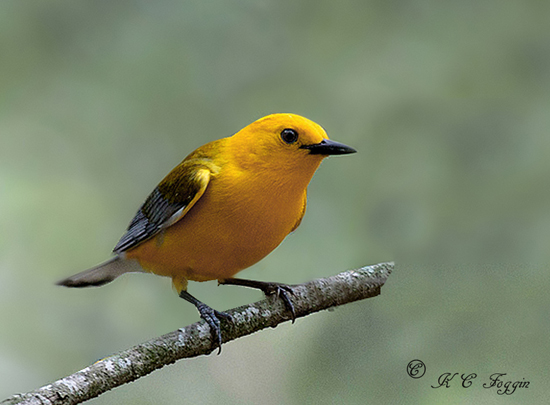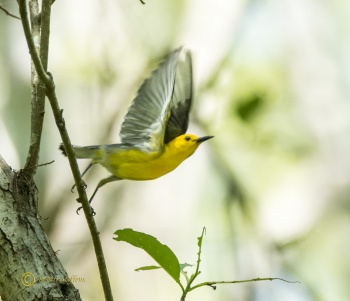Nutcracker (talk | contribs) m (link corrected) |
(→External Links: Additional GSearch for common name. GSearch Checked template) |
||
| (2 intermediate revisions by 2 users not shown) | |||
| Line 1: | Line 1: | ||
| − | [[Image:050817prothontarywarbler1aOPUS.jpg|thumb|550px|right|Photo by {{user|KC+Foggin|KC Foggin}}<br />Myrtle Beach, [[:Category:South Carolina|SC]], [[USA]], May 2017]] | + | [[Image:050817prothontarywarbler1aOPUS.jpg|thumb|550px|right|Photo © by {{user|KC+Foggin|KC Foggin}}<br />Myrtle Beach, [[:Category:South Carolina|SC]], [[USA]], May 2017]] |
| + | '''Alternative name: Golden Swamp Warbler''' | ||
;[[:Category:Protonotaria|Protonotaria]] citrea | ;[[:Category:Protonotaria|Protonotaria]] citrea | ||
==Identification== | ==Identification== | ||
| − | + | [[Image:Protonatory Warbler 74 7640.jpg|thumb|350px|right|Female<br />Photo © by {{user|STEFFRO1|STEFFRO1}}<br />Collins Creek Landing, Murrells Inlet, [[South Carolina]], 24 April 2020]] | |
| − | + | 14 cm (5½ in)<br /> | |
| − | + | Male | |
| − | + | *Bright orange-yellow head | |
| − | + | *Gold overall plumage | |
| + | *Bluish-grey wings | ||
| + | Female: slightly duller | ||
| + | *Olive upperparts | ||
| + | *Bluish-grey tail | ||
| + | *Yellow underparts | ||
| + | *Long pointed bill | ||
| + | *Black legs | ||
| + | Females and immature birds are duller and have a yellow head. | ||
==Distribution== | ==Distribution== | ||
| − | |||
Main breeding range from southwest [[Iowa]] east to [[Ohio]] south to eastern [[Texas]] east to [[Alabama]] and from southern [[New Jersey]] south to northern [[Florida]]. Mostly absent from the Appalachians. Small local populations in [[Pennsylvania]], [[New York]], [[Massachusetts]], [[Connecticut]] and [[Vermont]]. It winters in the [[West Indies]], [[Central America]] and northern [[South America]]. Rare vagrant to California, Nevada, Utah, Colorado, Arizona and New Mexico. | Main breeding range from southwest [[Iowa]] east to [[Ohio]] south to eastern [[Texas]] east to [[Alabama]] and from southern [[New Jersey]] south to northern [[Florida]]. Mostly absent from the Appalachians. Small local populations in [[Pennsylvania]], [[New York]], [[Massachusetts]], [[Connecticut]] and [[Vermont]]. It winters in the [[West Indies]], [[Central America]] and northern [[South America]]. Rare vagrant to California, Nevada, Utah, Colorado, Arizona and New Mexico. | ||
==Taxonomy== | ==Taxonomy== | ||
| + | [[Image:Prothonatary Warbler 73 7454.jpg|thumb|350px|right|Photo © by {{user|STEFFRO1|STEFFRO1}}<br />Collins Creek Landing, Murrells Inlet, [[South Carolina]], May 2017]] | ||
This is a [[Dictionary_M-S#M|monotypic]] species<sup>[[#References|[1]]]</sup>. | This is a [[Dictionary_M-S#M|monotypic]] species<sup>[[#References|[1]]]</sup>. | ||
==Habitat== | ==Habitat== | ||
| − | + | Seasonally flooded hardwood forests and swamps, along creeks and rivers. | |
==Behaviour== | ==Behaviour== | ||
| − | + | ====Diet==== | |
| + | Their main diet consists of insects such as butterflies, moths, flies, spiders and beetles; with the addition of molluscs such as snails. Outwith the breeding season will also include seeds, fruit and nectar. They forage low to the ground in shrubs and on fallen logs. | ||
| + | ====Breeding==== | ||
| + | They construct their nest near water in tree cavities about 2 m above ground, sometimes using old holes from the [[Downy Woodpecker]].. It is lined with moss. The clutch contains 3-7 glossy white eggs with brownish spots. Incubation takes about 12-14 days, fledging usually after 10 days. | ||
| − | + | They are sometimes parasitised by the [[Brown-headed Cowbird]] (Molothrus ater), or outcompeted for nest sites by the [[House Wren]] (Troglodytes aedon). | |
| + | ====Vocalisation==== | ||
| + | '''Call''': ''tsweet, twseet, twseet, twseet''. | ||
| − | |||
| − | |||
| − | |||
==References== | ==References== | ||
| − | #{{Ref- | + | #{{Ref-Clements6thAug19}}#Petit, L. J. (2020). Prothonotary Warbler (Protonotaria citrea), version 1.0. In Birds of the World (A. F. Poole and F. B. Gill, Editors). Cornell Lab of Ornithology, Ithaca, NY, USA. https://doi.org/10.2173/bow.prowar.01 |
{{ref}} | {{ref}} | ||
<!--EDITORS: Virtually all the text is C&P, replacing original unique to Opus input!--> | <!--EDITORS: Virtually all the text is C&P, replacing original unique to Opus input!--> | ||
| + | <!--EDITORS: ID, Habitat & Behaviour all re-written 25/04/20!--> | ||
==External Links== | ==External Links== | ||
| + | Search the Gallery using the scientific name: | ||
{{GSearch|Protonotaria+citrea}} | {{GSearch|Protonotaria+citrea}} | ||
| + | Search the Gallery using the common name: | ||
| + | {{GSearch|"Prothonotary Warbler"}} | ||
| + | {{GS-checked}} | ||
| + | <br /> | ||
| + | <br /> | ||
| + | |||
[[Category:Birds]][[Category:Protonotaria]] | [[Category:Birds]][[Category:Protonotaria]] | ||
Latest revision as of 19:54, 11 June 2022
Alternative name: Golden Swamp Warbler
- Protonotaria citrea
Identification
14 cm (5½ in)
Male
- Bright orange-yellow head
- Gold overall plumage
- Bluish-grey wings
Female: slightly duller
- Olive upperparts
- Bluish-grey tail
- Yellow underparts
- Long pointed bill
- Black legs
Females and immature birds are duller and have a yellow head.
Distribution
Main breeding range from southwest Iowa east to Ohio south to eastern Texas east to Alabama and from southern New Jersey south to northern Florida. Mostly absent from the Appalachians. Small local populations in Pennsylvania, New York, Massachusetts, Connecticut and Vermont. It winters in the West Indies, Central America and northern South America. Rare vagrant to California, Nevada, Utah, Colorado, Arizona and New Mexico.
Taxonomy
This is a monotypic species[1].
Habitat
Seasonally flooded hardwood forests and swamps, along creeks and rivers.
Behaviour
Diet
Their main diet consists of insects such as butterflies, moths, flies, spiders and beetles; with the addition of molluscs such as snails. Outwith the breeding season will also include seeds, fruit and nectar. They forage low to the ground in shrubs and on fallen logs.
Breeding
They construct their nest near water in tree cavities about 2 m above ground, sometimes using old holes from the Downy Woodpecker.. It is lined with moss. The clutch contains 3-7 glossy white eggs with brownish spots. Incubation takes about 12-14 days, fledging usually after 10 days.
They are sometimes parasitised by the Brown-headed Cowbird (Molothrus ater), or outcompeted for nest sites by the House Wren (Troglodytes aedon).
Vocalisation
Call: tsweet, twseet, twseet, twseet.
References
- Clements, J. F., T. S. Schulenberg, M. J. Iliff, S. M. Billerman, T. A. Fredericks, B. L. Sullivan, and C. L. Wood. 2019. The eBird/Clements Checklist of Birds of the World: v2019. Downloaded from http://www.birds.cornell.edu/clementschecklist/download/
- Petit, L. J. (2020). Prothonotary Warbler (Protonotaria citrea), version 1.0. In Birds of the World (A. F. Poole and F. B. Gill, Editors). Cornell Lab of Ornithology, Ithaca, NY, USA. https://doi.org/10.2173/bow.prowar.01
Recommended Citation
- BirdForum Opus contributors. (2024) Prothonotary Warbler. In: BirdForum, the forum for wild birds and birding. Retrieved 28 April 2024 from https://www.birdforum.net/opus/Prothonotary_Warbler
External Links
Search the Gallery using the scientific name:
Search the Gallery using the common name:
GSearch checked for 2020 platform.






